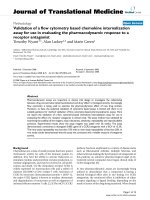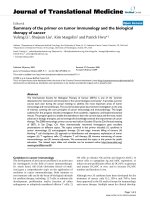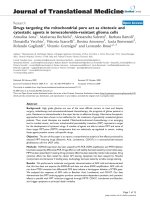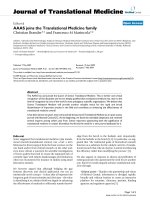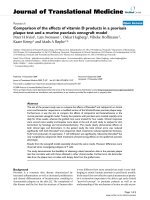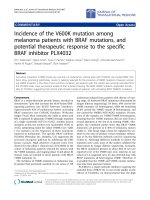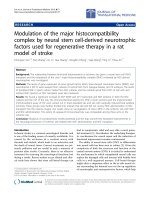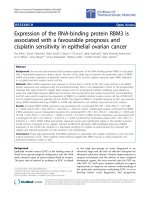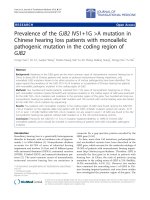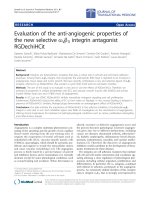Báo cáo hóa học: " Neurorehabilitation using the virtual reality based Rehabilitation Gaming System: methodology, design, psychometrics, usability and validation" pot
Bạn đang xem bản rút gọn của tài liệu. Xem và tải ngay bản đầy đủ của tài liệu tại đây (1.52 MB, 14 trang )
RESEA R C H Open Access
Neurorehabilitation using the virtual reality based
Rehabilitation Gaming System: methodology,
design, psychometrics, usability and validation
Mónica S Cameirão
1
, Sergi Bermúdez i Badia
1
, Esther Duarte Oller
2
, Paul FMJ Verschure
1,3*
Abstract
Background: Stroke is a frequent cause of adult disability that can lead to enduring impairments. Howe ver, given
the life-long plasticity of the brain one could assume that recovery could be facilitated by the harnessing of
mechanisms underlying neuronal reorganization. Currently it is not clear how this reorganization can be mobilized.
Novel technology ba sed neurorehabilitation techniques hold promise to address this issue. Here we describe a
Virtual Reality (VR) based system, the Rehabilitation Gaming System (RGS) that is based on a number of hypotheses
on the neuronal mechanisms underlying recovery, the structure of training and the role of individualization. We
investigate the psychometrics of the RGS in stroke patients and healthy controls.
Methods: We describe the key components of the RGS and the psychometrics of one rehabil itation scenario called
Spheroids. We performed trials with 21 acute/subacute stroke patients and 20 healthy controls to study the effect
of the training parameters on task performance. This allowed us to develop a Personalized Training Module (PTM)
for online adjustment of task difficulty. In addition, we studied task transfer between physical and virtual
environments. Finally, we assessed the usability and acceptance of the RGS as a rehabilitation tool.
Results: We show that the PTM implemented in RGS allows us to effectively adjust the difficulty and the parameters
of the task to the user by capturing specific features of the movements of the arms. The results reported here also
show a consistent transfer of movement kinematics between physical and virtual tasks. Moreover, our usability
assessment shows that the RGS is highly accepted by stroke patients as a rehabilitation tool.
Conclusions: We introduce a novel VR based paradigm for neurorehabilitation, RGS, which combines specific
rehabilitative principles with a psychometric evaluation to provide a personalized and automated training. Our
results show that the RGS effectively adjusts to the individual features of the user, allowing for an unsupervised
deployment of individualized rehabilitation protocols.
Background
Stroke is one of the main causes of adult disability [1]
and of burden of disease in high- and middle-income
countries with about 16 million first event stroke i nci-
dents per year [2-4]. Hence, both the economical and
the psycho-social impact of stroke emphasize that we
need to find effective diagnostics, treatment and rehab i-
litation approaches.
Recovery after a stroke relies on neuronal plasticity
that allows other areas of the brain to take over func-
tions of the ischemic zone, the complexity of this reor-
ganization strongly depends on the severity of the
anatomical and functional lesion [5-7]. Theref ore, the
main target of rehabilitation after stroke should be to
maximize the effect of plasticity and functional reorgani-
zation. Several methods and therapy concepts have been
proposed and many of them a im at promoting func-
tional changes within surviving motor networks [8-15].
However, it is not always clear how effective these
different approaches are and how they exactly influe nce
recovery.
* Correspondence:
1
Laboratory of Synthetic Perceptive Emotive and Cognitive Systems (SPECS),
Department of Technology, Universitat Pompeu Fabra, Edifici la Nau, Roc
Boronat 138, 08018 Barcelona, Spain
Full list of author information is available at the end of the article
Cameirão et al. Journal of NeuroEngineering and Rehabilitation 2010, 7:48
/>JNER
JOURNAL OF NEUROENGINEERING
AND REHABILITATION
© 2010 Cameirão et al; licensee BioMed Central Ltd. This is an Open Acces s article distributed under the te rms of the Creative
Commons Attributio n License ( /by/2.0), which permits unrestricted use, distribution, and
reproduction in any medium, provided the original work is properly cited.
Relatively novel tools in neurorehabilitation are based
on Virtual Reality (VR) technologies, these have the
advantage of flexibly d eploying scenarios that can be
directed towards s pecific needs. Several VR systems
have been proposed for the rehabil itation of motor defi-
cits following stroke with particular emphasis on the
rehabilitation of the upper limb and the hand (see
[16-18] for reviews). Although a significant amount of
work has been done in this area with promising results,
the relevant characteristics of these systems and the
quantification of their impact on recovery are not yet
clearlyunderstood[18].Asaresult,wedonotknow
how the different parameters of the proposed VR sce-
narios exactly affect recovery or whether they are effec-
tive at all. Furthermore, there is a need to take into
account individual variability in the deficits and the
behav ior of the subjects in order to optimize the impact
of training [19].
To address and investigate these aspects we have
developed the Rehabilitation Gaming System (RGS), a
VR based n eurorehabilitation paradigm for the treat-
ment of motor deficits resulting from lesions to the cen-
tral nervous system that exploits the cognitive processes
that mediate between perception and action [20,21].
RGS combines individualization with a brain based
training rationale. In the following paragraphs, we
describe the main considerations related to the design
of this system.
The RGS tracks arm and finger movements and maps
them onto a virtual environment. In this manner, the
user controls the movements of two virtual limbs that
are viewed in a first person perspective. The rehabilita-
tion scenario described here, Spheroids, c onsists of
intercepting, capturing and placing spheres that move
towards the user. The main rationale behind this rehabi-
litation scenario of RGS is the hypothesis that bimanual
task oriented action execution combined with the obser-
vation of virtual limbs that mirror the executed or
intended movement create conditions that facilitate the
functional reorganization of the motor and pre-motor
systems a ffected by stroke. In the action execution and
observation paradigm, recovery could be promoted
through the engagement of undamaged primary or
secondary motor areas or by recruiting alternative peri-
lesional or contralesional networks. This, however,
requires that an information channel must exist that
allows external modulation of the states of these alterna-
tive circuits. We hypothesize that such an interface
couldbeprovidedbyneuronssuchasthosefoundin
the mirror neuron system, which have the property of
being active both during t he execution of goal-oriented
actions with a biological effector and during the obser-
vation of the same actions performed by biological effec-
tors of other agents [22-26]. It is exactly this cognitive
transduction channel between the perception and execu-
tion of action that RGS exploits even when motor
actions themselves cannot be performed due to a lesion.
Indeed, recent studies have suggested a benefit of using
passive action observation for rehabilitation following
stroke [13].
In the mirror neuron literature, the perceptual frame
of reference is often not considered and the mirror neu-
rons are mainly reported in a third person perspective.
However, it has been acknowledged that these neurons
essentially follow the statistics of the multi-modal inputs
the acting b rain is exposed to [24]. This is consistent
with current theories of perceptual learning that empha-
size the role of sampling statistics in the development of
perceptual structures [27,28]. For instance, it h as been
proposed that through statistical infe rence, associating
motor intention and actions, the mirror neurons facili-
tate the encoding of the intentions of others [29]. Based
on these observations, RGS assumes that the first person
view should provide the most effective drive onto these
multi-modal populations of neurons simply because this
is the perspective that the systemismostfrequently
exposed to. Indeed, it has been observed that the first
person view of a virtual representation of the hand
induces stronger activation of primary and secondary
motor areas associated with sensory motor control as
opposedtoonlyperforminghandmovementsinthe
absence of such a representation [30]. More concretely,
the response is stronger when the orientation of the
hand is similar to the one of the first person perceiver
[31,32].
Since the Yerkes-Dodson law established the relation-
ship between motivation and learning, it has been
acknowledged that human performance is optimal at
intermediate levels of arousal [33,34]. This means that
the optimum experience in any task is the one that is
perfectly balanced so as to be neither too hard nor too
easy [35]. Given these considerations individualization
means to identify a level of performance, i.e. failure
rates, that optimally challenge each user at their own
level of competence. Hence, any automated therapy
system should be able to assess the performance level of
the subject and subsequently tune the therapeutic inter-
vention in relation to this level. Therefore, we quantita-
tively assessed the effect of each game parameter of the
Spheroids training scenario on the task pe rfo rma nce of
stroke patient s and healthy controls. This data was used
to define a multi-dimensional psychometric model of
the Spheroids RGS training scenario that could support
a Personalized Training Module (PTM) that automati-
cally adjusts the difficulty of the task with respect to the
measured performance of a subject.
Finally, RGS, as any other VR based rehabilitation
approach, assumes that training in virtual environments
Cameirão et al. Journal of NeuroEngineering and Rehabilitation 2010, 7:48
/>Page 2 of 14
will lead to corresponding impro vements in perfor-
mance in the physical w orld. Therefore, to understand
the transfer of perf ormance between the virtual and the
physical world, stroke patients and controls perf ormed
physical and virtual versions of a calibration reaching
task. We show that individual movement properti es and
deficits are consistently transferred between real and vir-
tual worlds, supporting the equivalence of training and
acting in both environments.
Our r esults indicate that by virtue of the above prop-
erties, the Rehabilitation Gaming System is a promising
neurorehabilitation tool that can be used to alleviate the
deficits brought on by lesions to the central nervous sys-
tem as the ones caused by stroke.
Methods
Participants
For the development of the Personalized Training Mod-
ule (PTM), 10 control subj ects (8 mal es and 2 females,
mean age 29.0 ± 6.1 years) and 12 hemiplegic patients
(11 males and 1 female, mean age 57.4 ± 12.1 years,
126.8 ± 108.2 days after stroke) participated in the trials.
For the assessment of the PTM and the study of transfer
between physical and virtual tasks two new groups o f
controls and patients were e nrolled. 10 control subjects
(8 males and 2 females, mean age 28.6 ± 3.6 years) and
9 patients (4 males and 5 females, mean age 62.3 ± 11.7
years, 13.1 ± 4.9 days after stroke) participated in the
study.
The control subjects were students with no history of
neurological disorders recruited from the SPECS
Laboratory at the Universitat Pompeu Fabra in Barce-
lona. All patients were receiving rehabilitation at the
Hospital de L’ Esperança in Barcelona (see Table 1 for
details). Patients were required to pass the Mini-Mental
State Examination with a minimum score of 22 (over
30) [36]. We excluded patients that displaye d emotional
and/or cognitive deficits that could interfere with the
understanding and execution of the ta sk, such as, for
instance, global aphasia, apraxia, dementia and depres-
sion. 4 patients and 8 controls reported previous experi-
ence in the use of computer games. The study followed
accepted guidelines and was approved by the ethics
committee of clinical research of the IMAS - Instituto
Municipal de Asistencia Sanitaria (Barcelona, Spain).
Rehabilitation Gaming System (RGS)
The RGS is implemented using: a PC (Intel Core 2 Duo
Processor, Palo Alto, USA) with graphics accelerator
(nVidia GeForce Go 7300, Sant a Clara, USA); a 17 inch
LCD display (Samsung, Daegu, South Korea); a color
CCD c amera (KE-240CV, Camt ronics, USA) positioned
on top of the display (Figure 1a); four color patches
(Figure 1b); and two 5DT data gloves (Fifth Dimension
Technologies, Johannesburg, South Africa) (not used in
the task described here) (Figure 1c). The virtual tasks
areimplementedwiththeTorqueGameEngine(TGE,
GarageGames, Oregon, USA). The movements of the
upper extremities of the patient are tracked using the
custom developed vision based motion capture system,
AnTS [37] (see Additional File 1 for a detailed
description).
Virtual scenario
The RGS scenario evaluated here, Spheroids, consists of
a green landscape populated with a number of trees
aga inst the background of a mountain range. Integr ated
in the virtual world is a model of a human torso with
arms positioned in such a way that the user has a first
person view of the upper extremities (Figure 2). The
movements of the user’s physical arms that are captured
by the motion capture system are mapped onto the
movements of t he virtual arms. The latter thus mimic
the movements of the user.
In Spheroids, spheres move towards the user and
these are to be intercepted through the movement of
the virtual arms. Each time a sphere is intercepted, the
user obtains a number of points that accumulate
towards a final sco re. The task is defined by different
gaming parameters, i.e. the speed of the moving spheres,
the interval between the appearance of consecutive
spheres and the horizontal range of dispersion of the
spheres in the field of view (Figure 2).
Calibration and diagnostics task
In order to assess the ecological validity of the RGS task,
we designed a directed pointing calibration and diagnos-
tics task. This task evaluates specific properties of arm
movements and analyzes their transfer between physical
and virtual worlds. In this way RGS also obtains kine-
matics based diagnostic information. For the physical
task, the user is asked to move his/her hands to num-
bered dots positioned at specific locations on the table-
top (Figure 3). There are four dots at each side of the
table with increasing numbering corresponding to differ-
ent reaching positions (Figure 3a). The user is instructed
by a text displayed on the RGS screen and a pre-
recorded audio statement to move one of the hands
from a resting position to a new positi on indicated by a
number corresponding to a position on the table top. In
each trial every hand and target position is randomly
defined by the system. The virtual version of the task i s
identical to the physical one and the user observes on
the computer screen a virtual replica of the table top
with the numbered dots and the task is to be performed
this time in the virtual scenario (Figure 3c).
In both, its real and virtual version, the calibration
task extracts information on the speed of movement,
Cameirão et al. Journal of NeuroEngineering and Rehabilitation 2010, 7:48
/>Page 3 of 14
range of movement (combined shoulder and elbow
aperture for arm extensio n) and latency (time to initiate
amovementfromastartcue).Inthetrainingsessions
this information is used to compute the baseline para-
meters of Spheroids and thus the starting difficulty of
the RGS training ses sion. In a ddition, this calibration
task is used to monitor the impact of training on arm
kinematics over sessions. The calibr ation task always
precedes every Spheroids session.
Personalized Training Module
The Personalized Training Module (PTM) can autono-
mously adjust the difficulty of the RGS sessions on a
trial by trial basis. This automated pro cedure follows a
number of steps (Figure 4). Before the training starts a
baselin e level is defined by means of the calibration task
described above. After every block of ten trials, i.e. deliv-
ery of ten spheres, the PTM adjusts the difficulty level
given the performance of the user. For each new diffi-
culty value the corresponding gaming parameters are
computed taking into account the previous response of
Table 1 Patient Description
Group ID Age Sex Days after
Stroke
Side of
Lesion
Type of
Stroke
Barthel Index
[54]
Brunnstrom Stage
[55]
Model Development 1 57 M 125 L H 72 IV
2 69 M 59 L H 61 III
3 57 M 120 L I 100 VI
4 43 F 21 R I 96 V
5 62 M 36 L I 91 VI
6 58 M 108 L I 98 V
7 73 M 135 L I 84 IV
8 45 M 24 L H 56 V
9 65 M 118 R I 72 IV
10 70 M 174 R H 62 V
11 58 M 176 L H 78 V
12 32 M 425 R I 78 II
Descriptive 57.4 11/
1
126.8 8/4 7/5 79.0 -
(12.1) (108.2) (15.1)
Model Assessment and Transfer
Task
1 79 F 20 R I 38 II
2 60 F 6 R H 42 III
3 67 M 13 R I 39 II
4 55 M 15 R I 41 II
579 F 9 L I 51 IV
6 50 F 10 L I 52 III
7 52 M 20 R H 31 II
8 50 F 15 R I 46 II
9 69 M 10 R I 43 III
Descriptive 62.3 4/5 13.1 2/7 7/2 42.6 -
(11.7) (4.9) (6.5)
The table shows sex with M = male and F = female, lesion side with L = left and R = right, and type of stroke with I = ischemic and H = hemorrhagic. The
descriptive statistics show the mean and the standard deviation.
Figure 1 The Rehabilitatio n Gaming System.Asubjectsitsona
chair with his/her arms on a table, facing a screen. Arm movements
are tracked by the camera mounted on top of the display (a). The
tracking system determines in real-time the position of the color
patches positioned at wrists and elbows and maps these onto a
biomechanical model of the upper extremities (b). Data gloves can
be used to detect finger movements (c). On the display two virtual
arms mimic the movements of the subject’s arms.
Cameirão et al. Journal of NeuroEngineering and Rehabilitation 2010, 7:48
/>Page 4 of 14
the user to the individual parameters and the psycho-
metric model of Spheroids.
In the instantiation of RGS presented here difficulty is
increased with 10% when the user intercepts more than
70% of the spheres up to a maximum difficulty level of
100%. Conversely difficulty is lowered with 5% if the
user intercepts less than 50% of the spheres. Hence,
there is a continuous adaptation of the game parameters
to the user’s performance. Additionally, individualization
is done for each arm separately, computing different dif-
ficulty levels and thus game parameters, for individual
arms.
In the context of the PTM, the performance of an
RGS user in the S pheroids task is asses sed as a function
of four individual parameters:
Performance f Speed Interval Range Size= (, , ,)
(1)
The investigation of the effect of these individual para-
meters on performance allowed us to establish a quanti-
tative relat ionship between multiple independent input
variabl es (game parameters) and a single output variable
(difficulty). Considering the broader case of a non-linear
relation between the input variables (task properties)
and the pe rformance of the subject, we used a quadratic
model that takes into account first-order terms, interac-
tions (cross-product terms) and second-order terms
[38]. For three input variables (x
1
,x
2
,x
3
)andoneout-
put variable y this renders:
ym mx mx mx
mxxmxxmxx
=+⋅+⋅+⋅+
+⋅⋅+⋅⋅+⋅⋅+
0112233
12 1 2 13 1 3 23 2 3
++⋅+ ⋅+ ⋅mxmxmx
11 1
2
22 2
2
33 3
2
(2)
where m
1
.x
1
m
3
.x
3
are the linear terms, m
12
.x
1
.x
2
m
23
.x
2
.x
3
are the interaction terms and m
11
.x
1
2
m
33
.x
3
2
are the quadratic terms. By fitting the model to the data
of interest, we can extract the regression parameters
(m coeffici ents), which best describe the contribution of
their respective terms or independent variables to the
dependent variable. In our case we evaluated the
Figure 2 Spheroids and the virtual environment .Thescenario
represents a spring-like nature scenario. Within this scenario two
virtual arms move accordingly to the movements of the user. The
virtual arms are consistent with the orientation of the user, pointing
towards the world, providing a first person perspective during the
virtual interaction. The difficulty of the sphere interception task is
modulated by the speed of the delivered spheres, the interval of
appearance between consecutive spheres and the range of
dispersion in the field of view. The gaming parameters are
graphically described in the Figure.
Figure 3 Calibration task. The user has to move his/her hands to
numbered dots positioned on a tabletop. (a) Coordinates (in cm) of
the target numbers to be reached. (b) Physical calibration task. The
task is performed on the physical tabletop. (c) Virtual calibration
task. Virtual replica of the physical calibration task. The instructions
are the same as in the real task, but now the task is to be
performed with the virtual arms on top of the virtual table.
Figure 4 Flow diagram of the RGS Personalized Training
Module. The game parameters are continuously updated based on
the performance of the subject. This provides an automated
adjustment of the difficulty of training over time based on a
psychometrically validated user model.
Cameirão et al. Journal of NeuroEngineering and Rehabilitation 2010, 7:48
/>Page 5 of 14
m coefficients that relate the game parameters to task
difficulty.
Protocol
To be able to assess the relationship between game
parameters and performance, stroke patients (n = 12)
and controls (n = 10) performed Spheroids with ran-
dom combinations of game parameters (i.e, speed, time
interval, range and size). For a specific combination,
each parameter could have one of four predefined
values: Speed = [8, 14, 19, 25] m/s, Interval = [.25, .50,
1.0, 1.5] s, Range = [.42, .69, .83, .97] m, and Size =
[.07, .14, .21, .28] m. We selected this set of parameters
in order to cover the behaviorally relevant part of the
parameter space while keeping the number of trials
within practical limits. We varied the gaming para-
meters every 10 trials (i.e., 10 spheres) to cover the total
number of 4
4
= 256 possible combinations. In each ses-
sion, the use r was exposed to a random subset of these
combinations. To avoid fatigue, we did sessions of a
maximum duration of 20 minutes. In a session of this
duration the average number of combinations was 82
(~820 spheres). Although there could be repetition of
combinations, we ensured that the full space of 256
possible combinations was covered for both, the
patients and controls. Subsequently, for e ach combina-
tion of parameters we assessed the average success rate
(number of successful sphere interceptions), separately
for patients and controls. The data form controls
allowed us to quantify the relation between performance
and game parameters. The model was then fitted to the
performance data from patient s. Given the data gener-
ated in these trials we could extract the parameters of
the psychometric model and define the PTM for the
online adaptation of difficulty. To evaluate the perfor-
mance of this psychometric model, two new groups of
patients (n = 9) and controls (n = 10) performed a 20
min sess ion of the automated Spheroids task. Addition-
ally, to asses the transfer between the physical and
virtual tasks in the RGS, the same group of patients
(n = 9) and controls (n = 10) performed the physical
and virtual versions of the calibration task.
Usability
In order to assess the usability aspects of the RGS, the
acceptance of the training and overall satisfaction con-
cerning the use of RGS, the group of patients (n = 9) that
performed the transfer task and the adaptive Spheroids
session were given a 4-item self-report questionnaire.
This questionnaire was presented in the format of a
5-point Likert scale and patients had to report their
agreement/disagreement with respect to a number of
statements. With this questionnaire we assessed a num-
ber of aspects such as enjoyment of the task,
understanding and ease of the task, and subjective perfor-
mance. Here we focused on the more general aspects
related to the usability and acceptance of the RGS.
Therefore, we reported on the answers giv en to two rele-
vant questions of the questionnaire.
Data analysis
To assess the main and interaction effects of the game
paramete rs on the perfor mance of the Spheroids task,
we performed a four way analysis of varian ce (ANOVA)
with the game score as the dependent variable and
Speed, Interval, Range and Size as independent variables.
Once we identified the main effects and interaction
effects between the parameters of the training scenario
and the user’s performance, we quantified this relation-
ship using a quadratic multiple regression model, and
extracted the parameters of the regression for both
patients and controls.
For the analysis of the performance data of the adap-
tive version of Spheroids, we extracte d the difficulty
level reached during the task (average of the 30 last
trials) and the final score (percentage of successful
sphere interceptions) separated for individual arms. Sub-
sequently, to analyze the mismatch between the perfor-
mance of the two arms, we computed the ratio of the
difficulty between the paretic and the nonparetic arm in
patients, and between nondominant and dominant arms
for controls. The same analysis w as done for the final
score. A ratio of 100% would represent a perfect match-
ing performance of the arms. We also analyzed the rela-
tion between the adapted gaming para meters for both
groups of subjects, by computing the average of the
individual parameters over the entire session.
For the analysis of transfer between physical and virtual
environments, we extracted the average speed during
movement and compute d the speed ratio between arms.
In addition, for both environments we analyzed the end-
point movement trajectories for su ccessful arm extension
movements between two points for both arms in patients
and contro ls. Here, trajectories are considered those that
successfully go between the two predefined fixed points -
the same ones in both calibration tasks - with an end-
point precision error smaller than 10 cm.
Within-subject data were compared using a paired Stu-
dent’ s t-tests or a Wilcoxon signed r anks test. For
between-subject comparisons we used an independent
sample t-test or a Mann-Whitne y test. p-values were not
corrected for multiple comparisons. The normality of th e
distribution was assessed using a single sample Lilliefors
hypothesis test of composite normality. Average data is
expressed as mean ± standard error of the mean in the
text and the figures, unless otherwise stated. For all sta-
tistical comparisons the significance level was set to 5%
(p < .05). All statistical analysis was performed using
Cameirão et al. Journal of NeuroEngineering and Rehabilitation 2010, 7:48
/>Page 6 of 14
MATLAB 2008a (MathWorks Inc., Natick, MA, USA)
and SPSS 16.0 (SPSS Inc., Chicago, IL, USA).
Results
We first evaluated the basic properties of the RGS by a
psychometric assessment of the performance of stroke
patients and control subjects, leading to the develop-
ment of the RGS’ PTM. We additionally assessed the
performance of patients a nd controls within the model.
Finally, we showed how the performance of the users
transfers between the physical and the virtual world.
Psychometric model
The Spheroids task is modulated by the Speed of the
spheres, Interval of appearance between consecutive
spheres, their Size, and Range of dispersal in the field
(see Methods). The performance data of the controls
showed that the size of the spheres had little effect,
while Interval, Range and Speed substantial ly modulated
performance (Figure 5). The 4-factor ANOVA revealed
main effects of Speed (F(2.62) = 62.78, p < .001), Inter-
val (F(2.62) = 64.41, p < .001) and Range (F(2.62) =
45.28, p < .001) while Size had no significant main effect
(F(2.62) = 1.52, p = .2071). With respect to the interac-
tion amo ng the game parameters we ob served that 3 o f
the 6 interaction s had a significant effect: Speed*Interval
(F(1.90) = 6.19, p < .001), Speed*Range (F(1.90) = 1.92,
p = .0473) and Interval*Range (F(1.90) = 1.97, p =
.0407). We did not find any further higher order interac-
tions. Taking into account the significant effects, we can
say that the difficulty of the task is defined by the
Speed, Interval and Range, and by the interactions Spee-
d*Interval, Spe ed*Range and Interva l*Range, and this
relation can be therefore quantified by a quadratic
model (see Methods):
Difficulty m m Interval m Speed m R ange
mInterval
=+⋅ +⋅ +⋅ +
+⋅
01 2 3
4
⋅⋅ + ⋅ ⋅ + ⋅ ⋅ +
+⋅ +
Speed m Interval Range m Speed Range
mInterval m
56
7
2
88
2
9
2
⋅+⋅Speed m Range
(3)
where Difficulty is inversely proportional to the game’s
score. In this model, positive values of difficulty corre-
spond to performance above average, while negative dif-
ficulty corresponds to performance below average.
For the controls we got a model fit (R
2
= 0.3745, F
(2.37) = 82.4866, p < .001) with a Mean Squared Err or
(MSE) of 0.0463. In order to determine the generaliza-
tion of the model, the stroke patients performed Spher-
oids following the same protocol. All patients were able
to complete the task irrespective of their degree of
impairment. Fitting our model to the data of the no n-
paretic hand we obtained a fit (R
2
= 0.3853, F(2.37) =
140.1967, p < .001) with a Mean Squared Error (MSE)
of 0.0531 (see Additional File 2 for the fitting para-
meters). The goal of the psychometric model is to
provide a single and “blind” adaptive rule fo r the update
of the game parameters that can apply to all patients.
Thus, the objective would be that the performance of
the paretic arm equals that of the nonparetic one at the
end of the treatment. For this reason we used the data
of the nonparetic arm to fit the model because it repr e-
sents an age matched approximation of the desired
treatment outcome. We found that the correlation of
the patients’ model with the parameters of the fit of the
healthy controls is .9557 (Pearson’ s correlation coef fi-
cient, p < .001). This means that the relationship
between Difficulty and the parameters of Spheroids was
consistent in both groups. Nevertheless, despite this cor-
relation, the weights found for the patients are higher
than for the controls. This can be explained by the fact
that the same game parameters in both groups represent
a more difficult task for the patients.
Personalized Training Module
Given the fit of t he data by the psychometric model we
quantitatively defined the relationship between task diffi-
culty and the game parameters allowing RGS to autono-
mously adjust the properties of the game to the abilities
of the user with PTM. The automated procedure of
PTM follows a number of defined st eps (Figure 4). As
an illustration of the application o f the PTM, consider
the perfo rmance and difficulty of the task achieved by a
patient during a single training session separated for the
paretic and non-paretic limbs (Figure 6). Analyzing the
game events (Figure 6a), i.e. hit and missed spheres dur-
ingthetask,weobserveahigherdegreeoffailureson
the paretic side because of a smaller range of movement.
The detecti on of the successful and unsuccessful events
for each arm was used by PTM to adjust the difficulty
ofthetrainingspecifictotheperformanceofthe
considered arm. This means that we had an individual
pattern of difficulty for each arm (Figure 6b).
The performance data from patients and controls in
the PTM showed that the model captured the individual
properties of the arms and adapted the difficulty level
accordingly (Figure 7). As expected, the patients reached
dissimilar difficulty levels for paretic and non paretic
arms, as opposed to the case of the controls. Conse-
quently, the difficult y ratio between arms was around
100% in controls (99.49 ± 4.11%) and lower in patients
(52.27 ± 17.54%), and these were significantly different
[t-test, t (8.8) = 2.62, p = .028] (Figure 7a). A correct
adaptive procedure requires that the difficulty of the
task is changed but the final score should be similar for
both arms in c ontrols and patients, and not different
between groups. Indeed, the score ratio between arms in
controls (95.17 ± 1.93%) and patients (95.21 ± 3.36%)
was not significantly different [t-test, t (17) = 009,
p = .993] (Figure 7b).
Cameirão et al. Journal of NeuroEngineering and Rehabilitation 2010, 7:48
/>Page 7 of 14
We identified specific properties of the individual
arms by exploring the individual gaming parameters
(range, speed, and time interval between spheres)
obtained for both arms in both groups, (Figure 7c, d).
For control subjects, we found no signi ficant differences
between dominant and nondominant arms in range
[t-test, t (9) = 055, p = .957], interval [t (9) = 1.199,
p = .261] and speed [t-test, t (9) = . 233, p = .821]. This
means that both arms showed similar properties duri ng
the task performance. On the othe r hand, for patients
we found significant differences between paretic and
nonparetic arms for interval [t-test, t (8) = -2.71, p =
.027] and speed [z = -2.07, p = .038], the paretic arm
being sl ower and requiring a longer time interval
between consecutive spheres. The paretic arm also
showed a smaller ra nge,butthedifferencewasnotsig-
nificant [Wilcoxon, z = -1.71, p = .086]. Comparing the
performance of th e individual arms between groups, the
patients’ paretic arm showed significantly lower range
and speed,andalongertimeinterval,whencompared
with controls ’ dominant and nondominant arms (pare-
tic-dominant: [t-test, t (17) = -2.64, p = .017] for range,
[t-test, t (17) = 2.69, p = .015] for interval and (Mann-
Whitney, z = -3.6 7, p = 2.2 × 10
-5
)forspeed;paretic-
nondominant: : [t-test, t (11.6) = -3.05, p = .010] for
range, [t-test, t (10.5) = 3.61, p = .004] for interval and
(Mann-Whitney , z = -3.59, p = 4.3 × 10
-5
)forspeed). In
contrast, patients’ nonparetic arm showed a similar
mean interval and range when compared to both arms
of the controls (nonparetic-dominant: (Mann-Whitney,
Figure 5 Performance versus game parameters in control subjec ts. a) Performance as a function of Size and Speed; b) Performance as a
function of Size and Interval; c) Performance as a function of Size and Range; d) Performance as a function of Interval and Speed; e)
Performance as a function of Range and Speed; f) Performance as a function of Range and Interval. Performance is measured as the percentage
of successful sphere interceptions.
Cameirão et al. Journal of NeuroEngineering and Rehabilitation 2010, 7:48
/>Page 8 of 14
z = -1.06, p = .288) for range and [t-test, t (17) = .333,
p=.743]forinterval; nonparetic-nondomina nt: (Mann-
Whitney, z = 653, p = .514) for range and [t-test,
t (17) = 1.66, p = .116] for interval). However, it had a
significant lower speed (nonparetic-dominant: [t-test,
t (17) = -5.26, p = 6.3 × 10
-5
], nonparetic-nondominant:
[t-test, t (17) = -5.18, p = 7.6 × 10
-5
]).
In summary, the nonparetic arm of the patients
showed similar properties as both arms of the contro l
group, although being slower in the performance of the
task. On the other hand, the paretic arm was noticeably
different from the control group and also from the con-
tralateral nonparetic arm. This means that our model
was capable of capturing the specific features of the user
Figure 6 Game events and task difficulty. (a) Arm reaching distance over time for paretic (red) and healthy (blue) arms, and corresponding
game events (hit and missed spheres). (b) Difficulty curves for paretic (red) and healthy (blue) arms over trials.
Figure 7 Adaptive game results. Difficulty (a) and score (b) ratios between the paretic and the nonparetic arms for patients (light grey); and
between the nondominant and dominant arms for controls (dark grey). (c-d) Relation between game parameters for individual arms. * p < .05.
Shown are means ± SEM.
Cameirão et al. Journal of NeuroEngineering and Rehabilitation 2010, 7:48
/>Page 9 of 14
for both arms and that it adapted the task parameters
accordingly.
Transfer between Real and Virtual Environments
For the RGS training, it is essential to understand the
transfer of performance between the virtual and the
physical world. For the control subjects we observe a
non-specific reduction in the speed of movement in the
virtual world when compared to the real world ([t-test,
t(8) = 4.324, p = .003] fo r the dominant arm and [t-test,
t(8) = 2.992, p = .017] for the nondominant arm)
(Figure 8 upper panel). This effect was not observed in
the patient group ([t-test, t(8) = 1.896, p = .095] for the
nonparetic arm arm and [t-test, t(8) = .453, p = .663]
for the paretic arm). Neverthel ess, for contr ols the rela-
tionship between arms was preserved in real and virtual
worlds. Thus, the movement speed of the dominant and
nondominant arms was not significantly different in
both environments (real: [t-test, t (8) = 1.91, p = .093];
virtual: [t-test, t ( 8) = . 296, p = .775]). For the stroke
patients (Figure 8 lower panel) we observed that there
was a significant difference between nonparetic and
paretic arms in bo th real [t-test, t (8) = 4.565, p =
.0018] and virtual [t-test, t (8) = 2.312, p = .049] envir-
onments. Specifically, the paretic- nonparetic speed ratio
was 50.38 ± 6 .14% in the physical task and 65.67 ±
17.75% in the virtual one, and these were not signifi-
cantly different [Wilc oxon, z = -1.007, p = .314]. This
means that although the specifics of the speed of move-
ment were not transferred, the relationship between the
speed of t he arms was preserved and thus the deficit,
understood as the relative speed difference between
paretic and nonparetic arms, was consistently trans-
ferred between environments.
Comparing the speed o f the individual arms between
groups, we observed that the nonparetic arm of the
patients was not significantly different from both arms
of the control subjects in real and virtual worlds (non-
paretic-dominant: [t-test, t (16) = -1.961, p = .068] for
the real and [t-test, t (16) = 925, p = .369] for the vir-
tual task; nonp aretic-nondo minant: [t-test, t (16) =
755, p = .461] for physical task and [t-test, t (16) =
-1.040, p = .314] for virtual task). We observed that in
all cases the speed of the paretic arm was significantly
different from controls (paretic-dominant: [t-test, t (16)
= -9.076, p = 1.1 × 10
-7
] for physical task and [t-test, t
(16) = -2.508, p = .023] for virtual task; paretic-nondo-
minant: [t-test, t (16) = -7.275, p = 1.8 × 10
-6
]forreal
task and [t-test, t (16) = -3.223, p = .006] for virtual
task).
Additionally, we e xamined the endpoint trajectories
for successful arm extension movements. Extension
movements between two fixed points in the real and vir-
tual calibration tasks show ed similar move ment proper-
ties across environments (Figure 9). In general, patients
showed more uneven movement patterns while controls
Figure 8 Movement speed in an equivalent real and virtual calibration task. Speed (mean ± SEM) for both arms, in controls and patients,
in real and virtual environments. * p < .05, ** p < .01.
Cameirão et al. Journal of NeuroEngineering and Rehabilitation 2010, 7:48
/>Page 10 of 14
showed smoother and more continuous movements. In
the particular case of the patients, it can be clearly
appreciated that less successful movements are achieved
by the paretic arm, being the few successful ones more
unstructured. On the other hand, controls showed a
balanced control of both arms and reduc ed movement
variability when compared to patients.
Usability and Acceptance
In order to assess the acceptance of the RGS, patients
were asked about the enjoyment and the ease of the
task. To the statement “I enjoyed the task”, 44.4% of the
patients strongly agreed, 44.4% agreed and 11.1% neither
agreed nor disagreed. To the statement “ Th e task was
easy” , 22.2% strongly agreed, 55.6% agreed, 11.1%
neither agreed nor disagreed and 11.1% disagreed. Based
on these results and as an overall analysis we feel confi-
dent to conclude that the acceptance of the RGS and its
tasks was very high.
Discussion
Here we presented the Rehabilitation Gaming System, a
novel paradigm for the rehab ilitation of motor deficits
after lesions to the central nervous system. RGS has a
number of properties that are consistent with our
current understanding of neuronal mechanisms of
stroke and its aftermath, and the function al require-
ments of rehabilitative training. First, it is neuroscience
based and exploits the neuronal processes of action
observation and execution, learning and recovery and
proposes corresponding rehabilitat ion strategies. Second,
by virtue of using VR it allows for the flexible creation
of scenarios directed towards specific needs. Third, the
proposed task studied here follows an individualized
training approach, adjusted to the capabilities of the
user. And fourth, RGS measures quantitative perfor-
man ce data for continuous monitoring of the pa tient to
evaluate his/ her progress over time, complement ing
clinical standard evaluation. A key component o f the
RGS is the Personalized Training Module (PTM). We
showed that it allows the automatic adjustment of the
difficulty level of the task to the user. In addition, we
showed that there is a consistent transfer of movement
speed between physical and virtual tasks.
RGS exploits the observation of goal-oriented move-
ments through a virtual representation of the body,
allowing the training of specific components of move-
ment through the systematic presentation of propriocep-
tive and visual feedback. It is widely accepted that
feedback of one’s actions in terms of movement patterns
Figure 9 Movement trajectories in an equivalent real and virtual calibration task. Endpoint movement t rajectorie s between two fixed
points in the real and virtual calibration task for both arms, in controls and patients. Left arm movements are mirrored to the right side to allow
for comparison.
Cameirão et al. Journal of NeuroEngineering and Rehabilitation 2010, 7:48
/>Page 11 of 14
and movement outcomes is critical for motor learning
[12,39,40]. In the specific case of the reinforced feedback
provided by virtual e nvironments, it has been observed
that such environments optimize the learning of com-
plex tasks in healthy subjects [41] and have a positive
impact on recovery following stroke [17]. Such feedback
could help enhancing the cortical changes associated
with motor learning [42,43], facilitating the acquisition
of new motor skills.
Other groups deployed VR systems for upper limb
rehabilitation with different paradigms [16]. As examples
we can find systems based on “learning by imitation”
that make use of a virtual teacher, w hose movements
are to be followed by the user [44]; systems that provide
reinforcing feedback concerning the quality of the
movements and the goal of the tasks [45]; systems that
provide haptic feedback [46]; systems that combine VR
with robot-assisted training [47]; systems that use video
capture virtual reality [48]; or even systems that use VR
to support the generation of motor images for mental
imagery ba sed techniques [49]. However, RGS provides
a new contribution to the field in the sense that it is
unique in the integration of a number of explicit
hypotheses on the neuronal substrate of perception,
learning and recovery in a single platform, exploiting
new insights in individualized task oriented training.
Of special relevance is t he psychometric PTM of the
RGS for online adaptation of task difficulty. This model
was developed by analyzing the relation be tween perfor-
mance and game parameters in stroke patients and con-
trols. The individual game parameters are weighted to
produce the appropriate game parameters that are
adapted online to the individual capabilities of the user.
One of the main po ints of this model is to ensure that
the task remains constantly interesting and challenging,
but without reaching high levels of demand that could
result in frustration or anxiety [35]. Here we showed
that with the PTM implemented in Spheroids we were
able to capture specific features of both arms in patients
and controls, and to adapt the difficulty of the task
accordingly.Inpatients,wewereabletoidentifyadis-
similar pattern of performance and task parameters in
paretic and nonparetic arms. The paretic arm always
required a lower lev el of difficulty in order to sustain
performance. Consequently, the difficulty ratio between
arms was significantly lower than for controls, which
showed a balanced performance for both arms. By ana-
lyzing the individual game parameters (speed of the
spheres, time interval between consecutive arms and
range of dispersion), the pe rformance of the paretic arm
of the patients was significantly different from the con-
tralateral arm and from the control group. On the other
hand, the nonparetic arm shared the same aspects of
the game dynamics with both arms of the controls,
except for speed, the nonparetic arm requiring a signifi -
cantly slower sphere speed during the game. We think
that this difference in the speed could be related to a
general slowing down in movements that has been
reported in stroke patients [50,51].
In order to ensure the ecological validity of training
with RGS we showed that aspects of the movement
kinematics, such as endpoint trajectories and deficit
properties, were transferred between two equivalent
tasks in real and virtual environments. Consistent with
previous research on movement transfer in physical and
virtual environme nts we observe that healthy subjects
were slower in the virtual environment [52], an effect
not displayed by the patient group.
Here we propose RGS as a generic paradigm for neu-
rorehabilitation that is currently applied specifically to
motor deficits of t he upper e xtremities. However, we
believe that this concept will smoothly generalize to
address other deficits of the skeletal-motor system
resulting from CNS lesions and possibly more central
perceptual and cognitive deficits such as neglect. We are
currently developing new training protocols for reha bili-
tation in clinics and for c ontinuous long-term at home
diagnostics and training that will allow us to directly
validate these assumptions.
We believe that the amalgamation of relevant features
of the RGS makes it a valuable rehabilitation tool. The
impact of RGS is currently the focus of studies with
both acute and chronic patients and preliminary results
support this belief [21,53].
Conclusions
The R ehabilitation Gaming System uses Virtual Reality
technology to implement training protocols in order to
provide neurorehabilitation training that allows for a
gradual and individualized treatment of def icits of the
upper extremities after stroke. In the near future we will
evaluate the use of RGS in longitudinal clinical studies
with stroke patients in both acute and chronic stages.
We expect to assess its specific impact on recovery and
in the management of daily life.
Patient’s consent
Written informed consent was obtained from the patient
for publication of this case report and accompanying
images. A copy of the written consent is available for
review by the Editor-in-Chief of this journal.
Additional material
Additional file 1: Tracking System - AnTS. Description and operation
of the vision based tracking system AnTS. Here we describe how AnTS
tracks colored patches placed at the wrists and elbows of the user, to
map the movements of the user onto the movements of the avatar.
Cameirão et al. Journal of NeuroEngineering and Rehabilitation 2010, 7:48
/>Page 12 of 14
Additional file 2: Performance versus Gaming Parameters.
Identification of the main effects and interaction effects between the
parameters of the training scenario and the user’s performance through
a four way analysis of variance (ANOVA) with the game score as the
dependent variable and Speed, Interval, Range and Size as independent
variables. Here we show the quantification of this relationship, through
the extraction of the parameters of the quadratic multiple regression for
both patients and controls.
Acknowledgements
The authors would like to thank: Lukas Zimmerli for his help in the
development of the virtual environment; Bernhard Spanlang at the
Polytechnic University of Catalonia for the development of the 3D model of
the avatar; and the occupational therapy staff at the Hospital de L’Esperança
in Barcelona for their support in running the experimental trials. We would
also like to say a special “thank you” to the patients themselves for their
kindness and availability to participate in this study.
This work was supported by the European Commission through the projects
PRESENCCIA [IST-2006-27731] and Rehabilitation Gaming System - RGS [EC-
FP7 Ambient Assisted Living Joint Programme, AAL-2008-1-119].
Author details
1
Laboratory of Synthetic Perceptive Emotive and Cognitive Systems (SPECS),
Department of Technology, Universitat Pompeu Fabra, Edifici la Nau, Roc
Boronat 138, 08018 Barcelona, Spain.
2
Servei de Medicina Física i
Rehabilitació, Hospital de L’Esperança, Barcelona, Spain.
3
Institució Catalana
de Recerca i Estudis Avançats (ICREA), Barcelona, Spain.
Authors’ contributions
MSC, SBB and PFMJV participated in the concept and development of the
Rehabilitation Gaming System. MSC and EDO were main contributors in the
acquisition of the data. MSC, SBB and PFMJV analysed and interpreted the
data. All authors revised and approved the current version of the
manuscript.
Competing interests
The authors declare that they have no competing interests.
Received: 16 March 2010 Accepted: 22 September 2010
Published: 22 September 2010
References
1. Hendricks HT, van Limbeek J, Geurts AC, Zwarts MJ: Motor recovery after
stroke: a systematic review of the literature. Arch Phys Med Rehabil 2002,
83:1629-1637.
2. Mathers CD, Loncar D: Projections of global mortality and burden of
disease from 2002 to 2030. PLoS Med 2006, 3:e442.
3. Strong K, Mathers C, Bonita R: Preventing stroke: saving lives around the
world. Lancet Neurol 2007, 6:182-187.
4. WHO: The global burden of disease: 2004 update. Book The global burden
of disease: 2004 update (Editor ed.^eds.) City: World Health Organization
2008.
5. Nudo RJ: Postinfarct cortical plasticity and behavioral recovery. Stroke
2007, 38:840-845.
6. Seitz RJ, Butefisch CM, Kleiser R, Homberg V: Reorganisation of cerebral
circuits in human ischemic brain disease. Restor Neurol Neurosci 2004,
22:207-229.
7. Murphy TH, Corbett D: Plasticity during stroke recovery: from synapse to
behaviour. Nat Rev Neurosci 2009, 10:861-872.
8. Altschuler EL, Wisdom SB, Stone L, Foster C, Galasko D, Llewellyn DME,
Ramachandran VS: Rehabilitation of hemiparesis after stroke with a
mirror. The Lancet 1999, 353:2035-2036.
9. Bhatt E, Nagpal A, Greer KH, Grunewald TK, Steele JL, Wiemiller JW,
Lewis SM, Carey JR: Effect of finger tracking combined with electrical
stimulation on brain reorganization and hand function in subjects with
stroke. Exp Brain Res 2007, 182:435-447.
10. Blanton S, Wilsey H, Wolf SL: Constraint-induced movement therapy in
stroke rehabilitation: perspectives on future clinical applications.
NeuroRehabilitation 2008, 23:15-28.
11. Butler AJ, Page SJ: Mental practice with motor imagery: evidence for
motor recovery and cortical reorganization after stroke. Arch Phys Med
Rehabil 2006, 87:S2-11.
12. Cirstea MC, Levin MF: Improvement of arm movement patterns and
endpoint control depends on type of feedback during practice in stroke
survivors. Neurorehabil Neural Repair 2007, 21:398-411.
13. Ertelt D, Small S, Solodkin A, Dettmers C, McNamara A, Binkofski F,
Buccino G: Action observation has a positive impact on rehabilitation of
motor deficits after stroke. Neuroimage 2007, 36(Suppl 2):T164-173.
14. Karni A, Meyer G, Jezzard P, Adams MM, Turner R, Ungerleider LG:
Functional MRI evidence for adult motor cortex plasticity during motor
skill learning. Nature 1995, 377:155-158.
15. Kwakkel G, van Peppen R, Wagenaar RC, Wood Dauphinee S, Richards C,
Ashburn A, Miller K, Lincoln N, Partridge C, Wellwood I, Langhorne P:
Effects of augmented exercise therapy time after stroke: a meta-analysis.
Stroke 2004, 35:2529-2539.
16. Cameirao MS, Bermudez i Badia S, Verschure PFMJ: Virtual Reality Based
Upper Extremity Rehabilitation following Stroke: a Review. Journal of
CyberTherapy & Rehabilitation 2008, 1 :63-74.
17. Holden MK: Virtual environments for motor rehabilitation: review.
Cyberpsychol Behav 2005, 8:187-211, discussion 212-189.
18. Lucca LF: Virtual reality and motor rehabilitation of the upper limb after
stroke: a generation of progress? J Rehabil Med 2009, 41:1003-1100.
19. Prabhakaran S, Zarahn E, Riley C, Speizer A, Chong JY, Lazar RM,
Marshall RS, Krakauer JW: Inter-individual variability in the capacity for
motor recovery after ischemic stroke. Neurorehabil Neural Repair 2008,
22:64-71.
20. Cameirão MS, Bermúdez i Badia S, Zimmerli L, Duarte Oller E,
Verschure PFMJ: The Rehabilitation Gaming System: a Virtual Reality
Based System for the Evaluation and Rehabilitation of Motor Deficits.
Virtual Rehabilitation 2007; Sep; Lido, Venice, Italy 2007, 29-33.
21. Cameirao MS, Bermudez IBS, Duarte Oller E, Verschure PF: The
rehabilitation gaming system: a review. Stud Health Technol Inform 2009,
145:65-83.
22. Gallese V, Fadiga L, Fogassi L, Rizzolatti G: Action recognition in the
premotor cortex. Brain 1996, 119(Pt 2):593-609.
23. Buccino G, Binkofski F, Fink GR, Fadiga L, Fogassi L, Gallese V, Seitz RJ,
Zilles K, Rizzolatti G, Freund HJ: Action observation activates premotor
and parietal areas in a somatotopic manner: an fMRI study. Eur J
Neurosci 2001, 13:400-404.
24. Rizzolatti G, Craighero L: The mirror-neuron system. Annu Rev Neurosci
2004, 27:169-192.
25. Iacoboni M, Dapretto M: The mirror neuron system and the
consequences of its dysfunction. Nat Rev Neurosci 2006, 7:942-951.
26. Mukamel R, Ekstrom AD, Kaplan J, Iacoboni M, Fried I: Single-Neuron
Responses in Humans during Execution and Observation of Actions. Curr
Biol 2010.
27. Wyss R, Konig P, Verschure PF: A model of the ventral visual system
based on temporal stability and local memory. PLoS Biol 2006, 4:e120.
28. Verschure PF, Voegtlin T, Douglas RJ: Environmentally mediated synergy
between perception and behaviour in mobile robots. Nature 2003,
425:620-624.
29. Kilner JM, Friston KJ, Frith CD: The mirror-neuron system: a Bayesian
perspective. Neuroreport 2007, 18:619-623.
30. August K, Lewis JA, Chandar G, Merians A, Biswal B, Adamovich S: FMRI
analysis of neural mechanisms underlying rehabilitation in virtual reality:
activating secondary motor areas. Conf Proc IEEE Eng Med Biol Soc 2006,
1:3692-3695.
31. Maeda F, Kleiner-Fisman G, Pascual-Leone A: Motor facilitation while
observing hand actions: specificity of the effect and role of observer’s
orientation. J Neurophysiol 2002, 87:1329-1335.
32. Strafella AP, Paus T: Modulation of cortical excitability during action
observation: a transcranial magnetic stimulation study. Neuroreport 2000,
11:2289-2292.
33. Yerkes RM, Dodson JD: The relation of strength of stimulus to rapidity of
habit formation. Journal of Comparative Neurology 1908, 18:459-482.
Cameirão et al. Journal of NeuroEngineering and Rehabilitation 2010, 7:48
/>Page 13 of 14
34. Calabrese EJ: Converging concepts: adaptive response, preconditioning,
and the Yerkes-Dodson Law are manifestations of hormesis. Ageing Res
Rev 2008, 7:8-20.
35. Csikszentmihalyi M: Flow: The Classic Work on How to Achieve Happiness
London: Rider & Co 2002.
36. Folstein MF, Folstein SE, McHugh PR: “Mini-mental state”. A practical
method for grading the cognitive state of patients for the clinician.
J Psychiatr Res 1975, 12:189-198.
37. Mathews Z, Bermúdez i Badia S, Verschure PFMJ: A Novel Brain-Based
Approach for Multi-Modal Multi-Target Tracking in a Mixed Reality
Space. INTUITION - International Conference and Workshop on Virtual Reality
2007; Sep; Athens, Greece 2007.
38. Cohen J, Cohen P, Werst SG, Aiken LS: Applied multiple regression/correlation
analysis for the behavioral sciences Psychology Press 2002.
39. Krakauer JW: Motor learning: its relevance to stroke recovery and
neurorehabilitation. Curr Opin Neurol 2006, 19 :84-90.
40. Krakauer JW, Ghilardi MF, Ghez C: Independent learning of internal
models for kinematic and dynamic control of reaching. Nat Neurosci
1999, 2:1026-1031.
41. Todorov E, Shadmehr R, Bizzi E: Augmented Feedback Presented in a
Virtual Environment Accelerates Learning of a Difficult Motor Task. J Mot
Behav 1997, 29:147-158.
42. Molina-Luna K, Hertler B, Buitrago MM, Luft AR: Motor learning transiently
changes cortical somatotopy. Neuroimage 2008, 40:1748-1754.
43. Nudo RJ: Adaptive plasticity in motor cortex: implications for
rehabilitation after brain injury. J Rehabil Med 2003, 7-10.
44. Holden MK, Dyar T: Virtual environment training: a new tool for
neurorehabilitation. Neurol Rep 2002, 26:62-71.
45. Piron L, Tonin P, Piccione F, Laia V, Trivello E, Dam M: Virtual Environment
Training Therapy for Arm Motor Rehabilitation. Presence 2005, 14:732-740.
46. Broeren J, Rydmark M, Bjorkdahl A, Sunnerhagen KS: Assessment and
training in a 3-dimensional virtual environment with haptics: a report on
5 cases of motor rehabilitation in the chronic stage after stroke.
Neurorehabil Neural Repair 2007, 21:180-189.
47. Merians AS, Tunik E, Fluet GG, Qiu Q, Adamovich SV: Innovative
approaches to the rehabilitation of upper extremity hemiparesis using
virtual environments. Eur J Phys Rehabil Med 2009, 45:123-133.
48. Rand D, Katz N, Weiss PL: Intervention using the VMall for improving
motor and functional ability of the upper extremity in post stroke
participants. Eur J Phys Rehabil Med 2009, 45:113-121.
49. Gaggioli A, Meneghini A, Morganti F, Alcaniz M, Riva G: A strategy for
computer-assisted mental practice in stroke rehabilitation.
Neurorehabil
Neural Repair 2006, 20:503-507.
50. Yarosh CA, Hoffman DS, Strick PL: Deficits in movements of the wrist
ipsilateral to a stroke in hemiparetic subjects. J Neurophysiol 2004,
92:3276-3285.
51. Horstman AM, Gerrits KH, Beltman MJ, Koppe PA, Janssen TW, de Haan A:
Intrinsic properties of the knee extensor muscles after subacute stroke.
Arch Phys Med Rehabil 2010, 91:123-128.
52. Levin MF, Knaut LA, Magdalon EC, Subramanian S: Virtual reality
environments to enhance upper limb functional recovery in patients
with hemiparesis. Stud Health Technol Inform 2009, 145:94-108.
53. Cameirão MS, Bermúdez i Badia S, Duarte Oller E, Verschure PFMJ: Using a
Multi-Task Adaptive VR System for Upper Limb Rehabilitation in the
Acute Phase of Stroke. Virtual Rehabilitation 2008; Aug; Vancouver, Canada
2008.
54. Granger CV, Albrecht GL, Hamilton BB: Outcome of comprehensive
medical rehabilitation: measurement by PULSES profile and the Barthel
Index. Arch Phys Med Rehabil 1979, 60:145-154.
55. Brunnstrom S: Recovery stages and evaluation procedures. Movement
Therapy in Hemiplegia: A Neurophysiological Approach New York: Harper &
Row 1970, 34-55.
doi:10.1186/1743-0003-7-48
Cite this article as: Cameirão et al.: Neurorehabilitation using the virtual
reality based Rehabilitation Gaming System: methodology, design,
psychometrics, usability and validation. Journal of NeuroEngineering and
Rehabilitation 2010 7:48.
Submit your next manuscript to BioMed Central
and take full advantage of:
• Convenient online submission
• Thorough peer review
• No space constraints or color figure charges
• Immediate publication on acceptance
• Inclusion in PubMed, CAS, Scopus and Google Scholar
• Research which is freely available for redistribution
Submit your manuscript at
www.biomedcentral.com/submit
Cameirão et al. Journal of NeuroEngineering and Rehabilitation 2010, 7:48
/>Page 14 of 14
